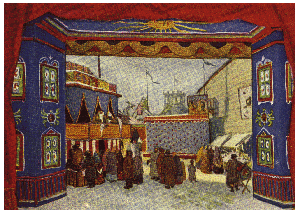
Alexander Benois' setting for Stravinsky's "Petrouchka," Scene I
The Ballet Russes
by Jenny Gorman and Chris Sippel
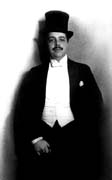
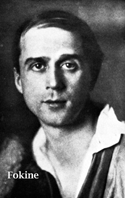 Its origins were in Russia, as
it was the homeland for almost all of the dancers, choreographers, composers, and
designers. However, the Ballets Russes never actually performed in Russia itself. After
the Revolution of 1905, it became clear to Diaghilev that there would be no hope for any
artistic reform in Russia. So, the Ballets Russes took up its home in Paris, in the spring
of 1909. The Ballets Russes, however, did not confine itself to merely the Parisian stage,
indeed, its performances took place across three continents, and subsequently, its
identity was as varied as was its audiences. The Ballets Russes was a continual experiment
in the diversity and potential that are represented in dance.(3)
Its origins were in Russia, as
it was the homeland for almost all of the dancers, choreographers, composers, and
designers. However, the Ballets Russes never actually performed in Russia itself. After
the Revolution of 1905, it became clear to Diaghilev that there would be no hope for any
artistic reform in Russia. So, the Ballets Russes took up its home in Paris, in the spring
of 1909. The Ballets Russes, however, did not confine itself to merely the Parisian stage,
indeed, its performances took place across three continents, and subsequently, its
identity was as varied as was its audiences. The Ballets Russes was a continual experiment
in the diversity and potential that are represented in dance.(3)
This experiment resulted in new ideas in the realms of theme, movement, set design, music, and costuming. Ideas for these new innovations frequently sprang from artistic endeavors other than dance, such as painting, avant-garde performance, and "new drama".
The Ballets Russes, however, did not completely move into a new, undiscovered territory. Choreography was one area where heritage and tradition were not ignored. The company's vernacular included classical steps, syntax, and rhetoric; the Ballets Russes broke the bonds that had originally confined the classicism of the nineteenth century and it new life.
The influence of the Ballets Russes was far reaching and its vestiges remain today. Both the Vic-Wells Ballet (now the Royal Ballet and the Ballet Theatre ( now the American Ballet Theatre) were founded by members of the Ballets Russes.
The undeniable head of this enterprise was Diaghilev, its president from its inception until his death, and the company's in 1929. "He was a man of ferocious will and infinitely discerning taste, encyclopedic knowledge, and passionate curiosity- a Napoleon of the arts and a Renaissance man in one." Beyond the Ballets Russes, Diaghilev also was the editor and founder of the journal Mir Iskusstra, which was an artistic forum, asking for change in every way.4
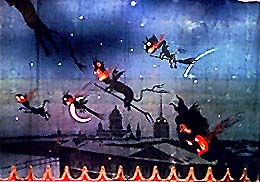 Along with
Diaghilev, founding members such as Alexandre Benois and Léon Bakst implemented a
collaborative method, which became the central development behind the company.(5) Two of
the early productions of the Ballets Russes were Petrouchka and Les Sylphides. Although both
were performed in its first seasons, each represented unique characteristics of the
Ballets Russes.
Along with
Diaghilev, founding members such as Alexandre Benois and Léon Bakst implemented a
collaborative method, which became the central development behind the company.(5) Two of
the early productions of the Ballets Russes were Petrouchka and Les Sylphides. Although both
were performed in its first seasons, each represented unique characteristics of the
Ballets Russes.
Petrouchka was produced in the 1911 season and was created jointly by Igor Stravinsky and Alexandre Benois and set to Stravinsky's score. The tale takes place in a crowded carnival in St. Petersburg during the 1830s. The scene includes many booths, one of which is owned by a Charlatan who has three dolls: the Dancer, Petrouchka, and a Blackamoor. Each of these dolls has been instilled with human characteristics and the possibility to experience human suffering. When left alone, the dolls act out a human drama. Petrouchka is jealous of the Dancer, while the Dancer is in love with the Blackamoor, who is incredibly narcissistic. As tensions arise between the three characters, they find themselves thrown into the main square of St. Petersburg and there the Blackamoor stabs Petrouchka. After the incident, the Charlatan is confronted by the spirit of the fallen Petrouchka who curses his cruelty of instilling human emotions in the dolls.(6)
Petrouchka was choreographed by Michael Fokine and its star was the famous Vaslev Nijinsky. It was a defining production of the Ballets Russes for several reasons. It was the first fundamental tragedy, it possessed authentic folk scenes, its choreography was new and surprising, and the execution of the dance itself was outstanding. The key to all of this was the unity of the whole artistic work.(7)
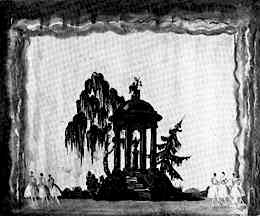 In contrast to Petrouchka,
Les Sylphides did not have a plot at all and was instead a combination of music and ballet
without a theme. The music was Chopin's, and Nijinsky,
Benois, and Fokine also collaborated. This ballet was centered solely on classical dance
and went through five phases: a polonaise, nocturne, mazurka, waltz, and tarantella.(8)
This ballet had a unity of dramatic movement and a bold and fluid choreography that
changed the character of modern dance.(9)
In contrast to Petrouchka,
Les Sylphides did not have a plot at all and was instead a combination of music and ballet
without a theme. The music was Chopin's, and Nijinsky,
Benois, and Fokine also collaborated. This ballet was centered solely on classical dance
and went through five phases: a polonaise, nocturne, mazurka, waltz, and tarantella.(8)
This ballet had a unity of dramatic movement and a bold and fluid choreography that
changed the character of modern dance.(9)
A noted innovation that originated from Les Sylphides was a costume design done by Benois. He created a new, long skirt for dancers that fell well below the knee. This gave a more subtle and feminine appearance and was a movement away from the short, traditional tutus of old.(10)
This ballet was created around the very ideals that spurred on the creative fire of the Ballets Russes. It was focused on group unity and collaboration, yet it was also concerned with personal freedom; subsequently its content centered around these ideals.(11)
![]()
Footnotes:
- Prince Peter Lieven. The Birth of the Ballets Russes. Dover Publications, inc: New York, 1963. 153
- Lynn Garafola. Diaghilev's Ballets Russes. Oxford University Press: Oxford, 1989, vii
- Ibid., viii
- Ibid., ix
- Ibid., x
- Lieven, 131-32
- Ibid., 145-45
- Garafola, 12
- Lieven, 72
- Garafola, 80
- Ibid., 48-49
Relevant Links
| Ballets Russes |
![]()